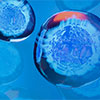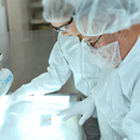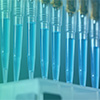PendoTech®+Single-Use+Sensors
Artikel-Nr:
(BOSSBS-11138R-A488)
Lieferant:
Bioss
Hersteller-Artikelnummer::
BS-11138R-A488
Lokale Artikelnummer::
BOSSBS-11138R-A488
Beschreibung:
Protocadherins are a large family of cadherin-like cell adhesion proteins that are involved in the establishment and maintenance of neuronal connections in the brain. There are three protocadherin gene clusters, designated alpha, beta and gamma, all of which contain multiple tandemly arranged genes. PCDHB4 (Protocadherin beta-4) is a 795 amino acid single pass transmembrane protein that is one of 16 proteins in the protocadherin beta cluster. Unlike the alpha and gamma gene clusters whose genes are spliced to downstream constant region exons during transcription, members of the beta cluster (such as PCDHB4) do not use constant-region exons to produce mRNAs. As a result, each protocadherin beta gene encodes the transmembrane, extracellular and short cytoplasmic domains of the protein. PCDHB4 is likely a calcium-dependent cell adhesion protein that is involved in the maintenance of neural connections in the brain.
VE:
1 * 100 µl
Lieferant:
Biotium
Beschreibung:
This antibody recognizes an oncofetal glycoprotein with a single chain of 70 kDa, which is identified as alpha fetoprotein (AFP). This MAb is highly specific to AFP and shows no cross-reaction with other oncofetal antigens or serum albumin. The yolk sac and the liver produce AFP during fetal life. AFP expression in adults is often associated with hepatoma or teratoma. However, hereditary persistence of alpha-fetoprotein may also be found in individuals with no obvious pathology. The protein is thought to be the fetal counterpart of serum albumin, and the AFP and albumin genes are present in tandem in the same transcriptional orientation on chromosome 4. AFP is found in monomeric as well as dimeric and trimeric forms, and binds copper, nickel, fatty acids and bilirubin. The level of AFP in amniotic fluid is used to measure renal loss of protein to screen for spinal bifida and anencephaly.
Lieferant:
Biotium
Beschreibung:
Recognizes a protein of 75 kDa, identified as mu heavy chain of human immunoglobulins. It does not cross-react with alpha (IgA), gamma (IgG), epsilon (IgE), or delta (IgD), heavy chains, T-cells, monocytes, granulocytes, or erythrocytes. Monomeric IgM is expressed as a membrane bound antibody on the surface of B cells and as a pentamer when secreted by plasma cells. IgM antibody is prominent in early immune responses to most antigens. Aberrant levels are associated with immune deficiency states, hereditary deficiencies, myeloma, Waldenstrom's macroglobulinemia, chronic infection and hepatocellular disease. This MAb is useful in the identification of leukemias, plasmacytomas, and certain non-Hodgkin's lymphomas. The most common feature of these malignancies is the restricted expression of a single heavy chain class. Demonstration of clonality in lymphoid infiltrates indicates that the infiltrate is clonal and therefore malignant.
Artikel-Nr:
(BOSSBS-11957R-CY5)
Lieferant:
Bioss
Hersteller-Artikelnummer::
BS-11957R-CY5
Lokale Artikelnummer::
BOSSBS-11957R-CY5
Beschreibung:
SLITRK family proteins are integral membrane proteins that have a C-terminal domain that is partially similar to TRK neurotrophin receptor proteins and two leucine-rich repeat (LRR) domains that are similar to those of SLIT proteins. SLITRK4 (SLIT and NTRK-like protein 4) is a 837 amino acid single-pass type I membrane protein that contains 18 LRR (leucine-rich) repeats and is expressed in neural tissues, specifically in the thalamus, hypothalamus, subventricular zone, CA3 region of the hippocampus and cortical plate. SLITRK4 may be upregulated in some astrocytic brain tumors such as glioblastomas, astrocytomas and primitive neuroectodermal tumors. As compared with its family member SLITRK2, SLITRK4 only weakly suppresses neurite outgrowth. A study using genome-wide transcriptional profiling suggested that the gene encoding SLITRK4, as well as the ARL5B and PLA2G7 genes, may be involved in the pathogenesis of preeclampsia.
VE:
1 * 100 µl
Artikel-Nr:
(BOSSBS-11957R-A750)
Lieferant:
Bioss
Hersteller-Artikelnummer::
BS-11957R-A750
Lokale Artikelnummer::
BOSSBS-11957R-A750
Beschreibung:
SLITRK family proteins are integral membrane proteins that have a C-terminal domain that is partially similar to TRK neurotrophin receptor proteins and two leucine-rich repeat (LRR) domains that are similar to those of SLIT proteins. SLITRK4 (SLIT and NTRK-like protein 4) is a 837 amino acid single-pass type I membrane protein that contains 18 LRR (leucine-rich) repeats and is expressed in neural tissues, specifically in the thalamus, hypothalamus, subventricular zone, CA3 region of the hippocampus and cortical plate. SLITRK4 may be upregulated in some astrocytic brain tumours such as glioblastomas, astrocytomas and primitive neuroectodermal tumours. As compared with its family member SLITRK2, SLITRK4 only weakly suppresses neurite outgrowth. A study using genome-wide transcriptional profiling suggested that the gene encoding SLITRK4, as well as the ARL5B and PLA2G7 genes, may be involved in the pathogenesis of preeclampsia.
VE:
1 * 100 µl
Artikel-Nr:
(BOSSBS-12859R-CY3)
Lieferant:
Bioss
Hersteller-Artikelnummer::
BS-12859R-CY3
Lokale Artikelnummer::
BOSSBS-12859R-CY3
Beschreibung:
Crystallins are the major proteins of the vertebrate eye lens, where they maintain the transparency and refractive index of the lens. Crystallins are divided into a, b, and g families, and the b- and g-crystallins also comprise a superfamily. Crystallins usually contain seven distinctive protein regions, including four homologous motifs, a connecting peptide, and N- and C-terminal extensions. b-crystallins constitute the major lens structural proteins. They associate into dimers, tetramers, and higher order aggregates. The b-crystallin subfamily is composed of several gene products, including bA1-, bA2-, bA3-, bA4-, bB1-, bB2- and bB3-crystallin. The bA1- and bA3-crystallin proteins are encoded by a single mRNA. They differ by only 17 amino acids, and bA1-crystallin is generated by use of an alternate translation initiation site. The genes for bA4-, bB1-, bB2- and bB3-crystallin are clustered on human chromosome 22q11, while the genes for bA3/A1- and bA2-crystallin map to human chromosomes 17q11 and 2q34, respectively.
VE:
1 * 100 µl
Artikel-Nr:
(115-1779)
Lieferant:
KIMBERLY CLARK
Hersteller-Artikelnummer::
6959
Lokale Artikelnummer::
KIMB6959
Beschreibung:
Dieser Spender eignet sich hervorragend für die Einzeltuchentnahme von SCOTT®/KLEENEX® Handtuchrollen. Perfekt für den Einsatz in häufig genutzten Waschräumen in Arbeitsbereichen, z. B. in der Lebensmittelverarbeitung und an öffentlichen Orten, wie zum Beispiel Flughäfen.
VE:
1 * 1 ST
Artikel-Nr:
(BOSSBS-11957R-FITC)
Lieferant:
Bioss
Hersteller-Artikelnummer::
BS-11957R-FITC
Lokale Artikelnummer::
BOSSBS-11957R-FITC
Beschreibung:
SLITRK family proteins are integral membrane proteins that have a C-terminal domain that is partially similar to TRK neurotrophin receptor proteins and two leucine-rich repeat (LRR) domains that are similar to those of SLIT proteins. SLITRK4 (SLIT and NTRK-like protein 4) is a 837 amino acid single-pass type I membrane protein that contains 18 LRR (leucine-rich) repeats and is expressed in neural tissues, specifically in the thalamus, hypothalamus, subventricular zone, CA3 region of the hippocampus and cortical plate. SLITRK4 may be upregulated in some astrocytic brain tumors such as glioblastomas, astrocytomas and primitive neuroectodermal tumors. As compared with its family member SLITRK2, SLITRK4 only weakly suppresses neurite outgrowth. A study using genome-wide transcriptional profiling suggested that the gene encoding SLITRK4, as well as the ARL5B and PLA2G7 genes, may be involved in the pathogenesis of preeclampsia.
VE:
1 * 100 µl
Artikel-Nr:
(BOSSBS-11957R-A555)
Lieferant:
Bioss
Hersteller-Artikelnummer::
BS-11957R-A555
Lokale Artikelnummer::
BOSSBS-11957R-A555
Beschreibung:
SLITRK family proteins are integral membrane proteins that have a C-terminal domain that is partially similar to TRK neurotrophin receptor proteins and two leucine-rich repeat (LRR) domains that are similar to those of SLIT proteins. SLITRK4 (SLIT and NTRK-like protein 4) is a 837 amino acid single-pass type I membrane protein that contains 18 LRR (leucine-rich) repeats and is expressed in neural tissues, specifically in the thalamus, hypothalamus, subventricular zone, CA3 region of the hippocampus and cortical plate. SLITRK4 may be upregulated in some astrocytic brain tumors such as glioblastomas, astrocytomas and primitive neuroectodermal tumors. As compared with its family member SLITRK2, SLITRK4 only weakly suppresses neurite outgrowth. A study using genome-wide transcriptional profiling suggested that the gene encoding SLITRK4, as well as the ARL5B and PLA2G7 genes, may be involved in the pathogenesis of preeclampsia.
VE:
1 * 100 µl
Artikel-Nr:
(BOSSBS-12859R-A647)
Lieferant:
Bioss
Hersteller-Artikelnummer::
BS-12859R-A647
Lokale Artikelnummer::
BOSSBS-12859R-A647
Beschreibung:
Crystallins are the major proteins of the vertebrate eye lens, where they maintain the transparency and refractive index of the lens. Crystallins are divided into a, b, and g families, and the b- and g-crystallins also comprise a superfamily. Crystallins usually contain seven distinctive protein regions, including four homologous motifs, a connecting peptide, and N- and C-terminal extensions. b-crystallins constitute the major lens structural proteins. They associate into dimers, tetramers, and higher order aggregates. The b-crystallin subfamily is composed of several gene products, including bA1-, bA2-, bA3-, bA4-, bB1-, bB2- and bB3-crystallin. The bA1- and bA3-crystallin proteins are encoded by a single mRNA. They differ by only 17 amino acids, and bA1-crystallin is generated by use of an alternate translation initiation site. The genes for bA4-, bB1-, bB2- and bB3-crystallin are clustered on human chromosome 22q11, while the genes for bA3/A1- and bA2-crystallin map to human chromosomes 17q11 and 2q34, respectively.
VE:
1 * 100 µl
Artikel-Nr:
(BOSSBS-13350R-CY3)
Lieferant:
Bioss
Hersteller-Artikelnummer::
BS-13350R-CY3
Lokale Artikelnummer::
BOSSBS-13350R-CY3
Beschreibung:
Gamma-glutamyltranspeptidase (GGT) acts as a glutathionase and catalyzes the transfer of the glutamyl moiety of glutathione to a variety of amino acids and dipeptide acceptors. This enzyme is located on the outer surface of the cell membrane and is widely distributed in mammalian tissues involved in absorption and secretion. In humans, hepatic GGT activity is elevated in some liver diseases. GGT1 is released into the bloodstream after liver damage, and an elevated level of the enzyme may be a useful early sign of hepatocellular carcinoma. GGT5 converts leukotriene C4 to leukotriene D4; it does not, however, convert synthetic substrates that are commonly used to assay GGT. In human serum and in human tissues, there is a marked heterogeneity in GGT, but this heterogeneity can be attributed to different glycosylation of the same peptide rather than to the products of different genes. Belonging to the gamma-glutamyltranspeptidase family, GGT6 (gamma-glutamyltransferase 6), is a 493 amino acid single-pass type II membrane protein that cleaves glutathione conjugates. GGT6 exists as two alternatively spliced isoforms.
VE:
1 * 100 µl
Artikel-Nr:
(BOSSBS-10438R-CY7)
Lieferant:
Bioss
Hersteller-Artikelnummer::
BS-10438R-CY7
Lokale Artikelnummer::
BOSSBS-10438R-CY7
Beschreibung:
This gene is a member of the beta-1,3-galactosyltransferase (beta3GalT) gene family. This family encodes type II membrane-bound glycoproteins with diverse enzymatic functions using different donor substrates (UDP-galactose and UDP-N-acetylglucosamine) and different acceptor sugars (N-acetylglucosamine, galactose, N-acetylgalactosamine). The beta3GalT genes are distantly related to the Drosophila Brainiac gene and have the protein coding sequence contained in a single exon. The beta3GalT proteins also contain conserved sequences not found in the beta4GalT or alpha3GalT proteins. The carbohydrate chains synthesized by these enzymes are designated as type 1, whereas beta4GalT enzymes synthesize type 2 carbohydrate chains. The ratio of type 1:type 2 chains changes during embryogenesis. By sequence similarity, the beta3GalT genes fall into at least two groups: beta3GalT4 and 4 other beta3GalT genes (beta3GalT1-3, beta3GalT5). The encoded protein of this gene does not use N-acetylglucosamine as an acceptor sugar at all. Multiple transcript variants that are alternatively spliced in the 5' UTR have been described; they all encode the same protein.
VE:
1 * 100 µl
Artikel-Nr:
(BOSSBS-10438R-A350)
Lieferant:
Bioss
Hersteller-Artikelnummer::
BS-10438R-A350
Lokale Artikelnummer::
BOSSBS-10438R-A350
Beschreibung:
This gene is a member of the beta-1,3-galactosyltransferase (beta3GalT) gene family. This family encodes type II membrane-bound glycoproteins with diverse enzymatic functions using different donor substrates (UDP-galactose and UDP-N-acetylglucosamine) and different acceptor sugars (N-acetylglucosamine, galactose, N-acetylgalactosamine). The beta3GalT genes are distantly related to the Drosophila Brainiac gene and have the protein coding sequence contained in a single exon. The beta3GalT proteins also contain conserved sequences not found in the beta4GalT or alpha3GalT proteins. The carbohydrate chains synthesized by these enzymes are designated as type 1, whereas beta4GalT enzymes synthesize type 2 carbohydrate chains. The ratio of type 1:type 2 chains changes during embryogenesis. By sequence similarity, the beta3GalT genes fall into at least two groups: beta3GalT4 and 4 other beta3GalT genes (beta3GalT1-3, beta3GalT5). The encoded protein of this gene does not use N-acetylglucosamine as an acceptor sugar at all. Multiple transcript variants that are alternatively spliced in the 5' UTR have been described; they all encode the same protein.
VE:
1 * 100 µl
Artikel-Nr:
(BOSSBS-10438R-HRP)
Lieferant:
Bioss
Hersteller-Artikelnummer::
BS-10438R-HRP
Lokale Artikelnummer::
BOSSBS-10438R-HRP
Beschreibung:
This gene is a member of the beta-1,3-galactosyltransferase (beta3GalT) gene family. This family encodes type II membrane-bound glycoproteins with diverse enzymatic functions using different donor substrates (UDP-galactose and UDP-N-acetylglucosamine) and different acceptor sugars (N-acetylglucosamine, galactose, N-acetylgalactosamine). The beta3GalT genes are distantly related to the Drosophila Brainiac gene and have the protein coding sequence contained in a single exon. The beta3GalT proteins also contain conserved sequences not found in the beta4GalT or alpha3GalT proteins. The carbohydrate chains synthesized by these enzymes are designated as type 1, whereas beta4GalT enzymes synthesize type 2 carbohydrate chains. The ratio of type 1:type 2 chains changes during embryogenesis. By sequence similarity, the beta3GalT genes fall into at least two groups: beta3GalT4 and 4 other beta3GalT genes (beta3GalT1-3, beta3GalT5). The encoded protein of this gene does not use N-acetylglucosamine as an acceptor sugar at all. Multiple transcript variants that are alternatively spliced in the 5' UTR have been described; they all encode the same protein.
VE:
1 * 100 µl
Artikel-Nr:
(BRDY321972)
Lieferant:
Brady
Hersteller-Artikelnummer::
321972
Lokale Artikelnummer::
BRDY321972
Beschreibung:
Das kombinierte Farb-/Schwarzband von Magicard™ ist perfekt für Vollfarbdrucke auf der einen und Schwarzdrucke auf der anderen Seite mit einem Magicard™ 300-Drucker.
VE:
1 * 1 ST
New Product
Artikel-Nr:
(BOSSBS-13350R)
Lieferant:
Bioss
Hersteller-Artikelnummer::
BS-13350R
Lokale Artikelnummer::
BOSSBS-13350R
Beschreibung:
Gamma-glutamyltranspeptidase (GGT) acts as a glutathionase and catalyzes the transfer of the glutamyl moiety of glutathione to a variety of amino acids and dipeptide acceptors. This enzyme is located on the outer surface of the cell membrane and is widely distributed in mammalian tissues involved in absorption and secretion. In humans, hepatic GGT activity is elevated in some liver diseases. GGT1 is released into the bloodstream after liver damage, and an elevated level of the enzyme may be a useful early sign of hepatocellular carcinoma. GGT5 converts leukotriene C4 to leukotriene D4; it does not, however, convert synthetic substrates that are commonly used to assay GGT. In human serum and in human tissues, there is a marked heterogeneity in GGT, but this heterogeneity can be attributed to different glycosylation of the same peptide rather than to the products of different genes. Belonging to the gamma-glutamyltranspeptidase family, GGT6 (gamma-glutamyltransferase 6), is a 493 amino acid single-pass type II membrane protein that cleaves glutathione conjugates. GGT6 exists as two alternatively spliced isoforms.
VE:
1 * 100 µl
Preis auf Anfrage
Lager für diesen Artikel ist begrenzt, kann aber in einem Lagerhaus in Ihrer Nähe zur Verfügung. Bitte stellen Sie sicher, dass Sie in sind angemeldet auf dieser Seite, so dass verfügbare Bestand angezeigt werden können. Wenn das
Lager für diesen Artikel ist begrenzt, kann aber in einem Lagerhaus in Ihrer Nähe zur Verfügung. Bitte stellen Sie sicher, dass Sie in sind angemeldet auf dieser Seite, so dass verfügbare Bestand angezeigt werden können. Wenn das
Dieses Produkt kann nur an eine Lieferadresse versandt werden die über die entsprechende Lizenzen verfügt. Für weitere Hilfe bitte kontaktieren Sie Ihr VWR Vertriebszentrum.
-Additional Documentation May be needed to purchase this item. A VWR representative will contact you if needed.
Dieses Produkt wurde von Ihrer Organisation gesperrt. Bitte kontaktieren Sie Ihren Einkauf für weitere Informationen.
Dieses Produkt ist Ersatz für den von Ihnen gewünschten Artikel.
Dieses Produkt ist nicht mehr verfügbar. Bitte kontaktieren Sie den VWR Kundenservice.
|
|||||||||

















































